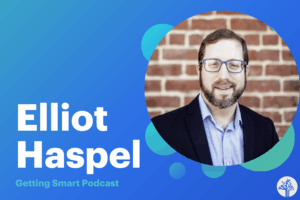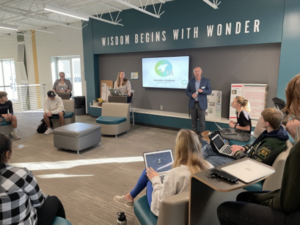WSJ Picks Problems, Misses the Promise of Learning Online
 The WSJ ran a generally negative article this morning about full time online learning. There was some attempt to sample the breadth of the emerging digital learning landscape and the authors did point to several successful blended school models including SW Learning and Rocketship. But as past chair of the International Association for K-12 Online Learning, I found eight problems with the article:
The WSJ ran a generally negative article this morning about full time online learning. There was some attempt to sample the breadth of the emerging digital learning landscape and the authors did point to several successful blended school models including SW Learning and Rocketship. But as past chair of the International Association for K-12 Online Learning, I found eight problems with the article:
1. The title, My Teacher in an App, is intentionally inflammatory. As this interview with K12 teachers indicates, many students and teachers indicate a stronger and more personalized relationship learning online.
2. They used one example of a Florida Virtual School student that could not contact his algebra teacher and attempted to create the impression of a lack of support. Florida Virtual successfully serves over 250,000 students each year because they are intensely consumer focused. This is simply not a fair characterization of FLVS or more online programs where the primary benefit is more immediate feedback from teachers and online tools.
3. The article points to lower math scores and less progress for full time online students. I’m afraid this is just not an accurate comparison. Like charter schools, the longer students stay in online schools the better they do.
4. They trot out the arguments against homeschooling, ‘kids need to be socialized’ stuff but make no attempt to look at how social the lives of full time online students are. While it varies, many full time online students engage in a range of community-based activities. Learning online is also becoming far more social.
5. They suggest that online school is easy, lacking in debate and dialog. That generalization is no more true of online schools than traditional schools. I spend part of the last three days with teachers from Open High of Utah; they run a full time virtual program that is rigorous, engaging, and rich with dialog.
6. They cite the NEA’s opposition to online schools with misleading suggestion that online learning replaces teachers. They may not be members, but full and part time online programs (just like traditional schools) rely on the dedication and talent of great teachers.
7. They call the Florida Virtual history course a video game and suggest kids breeze through it. Conspiracy Code is an innovative game-based approach to both English and history that engages students and build persistence but is certainly no less rigorous than a traditional course.
8. They close with a quote taken badly out of context where a teacher said, “letting a child educate himself” is a bad idea. Obviously, but that has nothing to do with any of the full time online programs featured in the article. The title and conclusion of this piece are intentionally misleading and much of the rest is just selective generalizations.
Here’s six things they missed:
1.Two-thirds of American kids don’t get what they need or deserve from school (and that’s before we raise the bar to real college/career ready standards).
2. Options are good. Families choose full time online options for many reasons.
3. Online is accountable. All of these programs operate under a performance contract with a nonprofit board which enters into a performance contract with the state. These two levels of accountability are stronger than what is in place for traditional schools.
4. Geography is no longer a barrier. Except where states (and spotty broadband) get in the way, every American student now has access to a rigorous well taught K-12 curriculum.
5. Scale is no longer a barrier. Quality at scale is the education challenge of our day, but we finally have a dozen (nonprofit and for-profit) providers that together could give every student in America access to every AP course, every STEM course, and every foreign language. If Duncan wanted to offer free online summer school to every student, it would be a snap. The only thing standing in the way of access to quality teachers and courses is local and state policy.
6. The world is blended. Our kids are digital but our schools are stuck in the world we grew up in. For the last 15 years, full time online learning has been a great option for a few kids. This small market is developing platforms and practices that will revolutionize schools. By the end of this decade, most U.S. schools will blend the best of online and onsite learning.







Tom Vander Ark
Here's 3 points from a senior manager at Florida Virtual School:
1. Competency-based learning allows students to vary rate, time, and location. When the student references working night and day and completing in 2 weeks, he literally worked 8-10 hours a day and over weekends while he was off school.
2. This story illustrates how virtual school meet the unique needs of students. Facing a health issue, this young lady fell behind and FLVS helped her catch up.
http://www.infobarrel.com/How_Florida_Virtual_School_FLVS_Saved_My_High_School_Career
3. The parent of the student (Noah) referenced in the WSJ article is furious. The child wasn't even taking Algebra and she felt the story regarding her son was highly inaccurate. She plans to write a rebuttal.